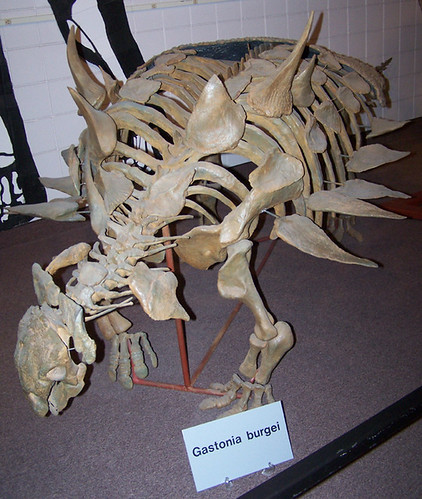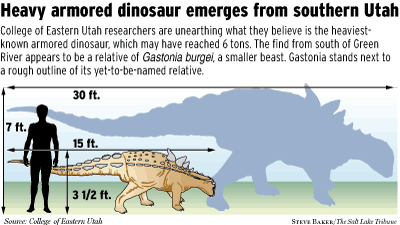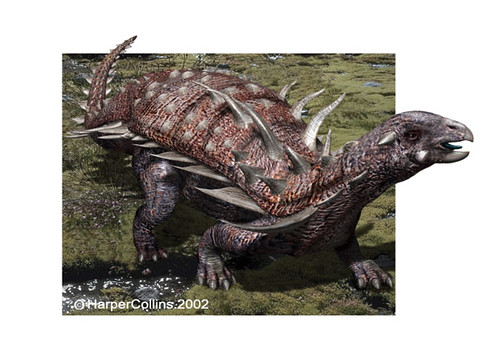
Gastonia burgei,
an "armored tank" dinosaur, so named in 1995 for Don Burge, the founding director of the
CEU Prehistoric Museum, and for amateur rock hound, Robert Gaston, who co-discovered
the species. This species appears to be a close relative to the newly discovered dinosaur
featured in this story, which has yet to be named.
Image: CEU Prehistoric Museum. (image resized).
The biggest armored dinosaur to be discovered so far was recently found in southern Utah, in a rugged badland just south of Green River.
"It's built like a tank," stated Reese Barrick of the new dinosaur. Barrick is a paleontologist who is the Director and Curator of the College of Eastern Utah (CEU) Prehistoric Museum in Price, Utah. "It will be the largest, heaviest armored dinosaur found on the planet so far."
Estimated to be 25-30 feet long and to weigh 6 tons, this newly discovered animal was adorned with spikes and bony plates along its back and sides, similar to another armored dinosaur that was also found in Utah. But its relatively diminutive cousin, Gastonia burgei (pictured, top, also at bottom), is merely one-half as long and one-third as heavy as this still-unnamed creature [below graphic: College of Eastern Utah].
 The bony plates and spikes protected this herbivorous creature from predators, such as the voracious Utahraptor.
The bony plates and spikes protected this herbivorous creature from predators, such as the voracious Utahraptor.
"Its best defense is just to stand there or even kneel down so there's no way an animal can get to where the soft underbelly would be," noted Barrick.
Barrick observed that Gastonia and this new find, though probably related, may have behaved differently from each other. Because larger creatures need to roam more territory to stay well-fed, this could have prompted this potential new species to to keep to itself, he suggested.
Indeed, this new creature was the only specimen of this species found, whereas Gastonia burgei specimens are found in small groups.
This skeleton is still incomplete: only a few vertebrae that are approximately two feet long, ribs that are at least four feet long and several pieces of armor plating have been found so far. [ram: 1:59]
Even though Barrick and his students first unearthed the gigantic prehistoric bones last summer, Barrick said they must find more bones before they can fully describe the animal. When they formally describe this animal for science, they will give it a unique scientific name, too. They also plan to put the prepared bones on public display within the year.
The Green River region where these bones were found is one of the richest fossil sites in Utah. The site was discovered in 2004 by two graduate students from Temple University, Celina and Marina Suarez. Later, state paleontologist Jim Kirkland turned the site over to CEU, and they have worked the area for the previous two years. Thus far, this area has yielded more that 300 fossil bones, most from already known therizinosaurs, including the transitional species, Falcarius utahensis, that was discovered on a nearby plateau. Falcarius represents part of this group's evolution away from eating meat to consuming plants.
"[This is] our own cretaceous park and here is a strip that goes from Alberta down through Montana, Colorado, Wyoming, Utah and New Mexico that is a dinosaur freeway, and we are sitting in the middle of this dinosaur country," noted Jeff Bartlett, a paleontologist and director of research at CEU's Prehistoric Museum. "We're finding a spectacular trove of bones," he added.
This new dinosaur species is thought to have lived during the Cretaceous era, approximately 125 million years ago.
After locating more bones, CEU scientists will begin studying them to learn how much food these huge herbivores had to eat and how rapidly they grew as they matured.

Gastonia burgei, artist's rendition. This is a close relative of the
newly-discovered, and still unnamed, creature.
Image: by kind permission of Jon Hughes and Russell Gooday.
Sources:
Story: Salt Lake Tribune by Greg Lavine [graphic, quotes]
Story and video: KSL.com [quotes, video interview and includes lots of looks at the bones. RealPlayer (1:59)]
CEU Prehistoric Museum [Featured image, top]
.
- Log in to post comments

Having grown up in Utah, I'm always (sadly) amused by the irony of a state that has so many wonderful fossil beds, and so many gorgeous displays of rock layers being home to so many creationists.
Okay, probably a really stupid question, but could this new armored dinosaur just be the parent of the other smaller one found--the first one was just a juvenile? I guess there must be other differences...
good question, beth, but unfortunately, this is a question that we have to wait to be answered since there are only a few individual bones that have been discovered so far. my sources inform me that the press release for this dino was very premature, which is a definite disappointment for all of us who wish to know more -- there isn't anything else that we can learn right now! i guess scientists can't resist the siren song of the media any better than politicians can.
Jeff Bartlett wrote to me regarding this story, and generously included a series of photos of the bones they've prepared so far. The photos of the bones will be appearing as soon as I can upload them.
But Jeff also responded to my comment, and to be fair to him, I am putting his response here for all to read because it reveals a little about how this story came about and the firestorm of attention that results;
I am 7 years old and Gastonia is cool. I just finished a paper mache gastonia for school he is brown with blue spikes. I want to be a paleontologist when I grow up.I have over 100 dinosaur books and I read them every day and I look on the web with my mom and dad. Last summer we went to the Royal Tyrell Museum with my Nana and Grandpa Gord. This summer I want to go to Tumbler ridge and see their dig. They have caves with fossils you can go in if you are careful. I liked your pictures and I printed it off for my dinosaur wall. Thank you
Marcus